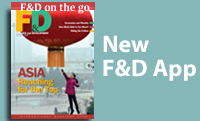Asia: Achieving Its Potential
Finance & Development, June 2014, Vol. 51, No. 2
The region’s success is not guaranteed

Asia has led global growth for the past several decades, with an average rate of close to 6 percent since 1990. If the current trend continues, Asia’s economy will be larger than that of the United States and the European Union combined in less than two decades.
While Asia’s future appears bright, its success is not guaranteed. It depends crucially on choosing the right policy mix to contain risks and secure growth.
In the near term, the region faces some emerging vulnerabilities and may continue to be buffeted by volatility in global markets.
And over the medium term, all parts of this diverse region must confront challenges:
• Asia still has close to 700 million poor people—65 percent of the world’s poor, defined as an income of less than $1.25 a day—and income inequality is growing.
• The region’s emerging markets face the task of moving beyond middle-income status and joining the ranks of advanced economies.
• Several of Asia’s industrial economies have embarked on the difficult process of transforming their growth model.
Resilience and growth
The year 2013 witnessed several spells of global financial volatility, leading to a pullback in capital flows from emerging markets, including in Asia. But Asia has remained broadly resilient to global risk, even as some of its economies’ buffers have been tested by the retreat of external funding. Swift actions taken to address vulnerabilities are starting to bear fruit, and the growth momentum is set to continue.
Asia is projected to grow at 5.5 percent in 2014 and 5.6 percent in 2015, retaining its global growth leadership. Exports will pick up as the recovery continues in advanced economies, while domestic demand across the region will be supported by healthy labor markets and strong credit growth.
With continued tightening of global liquidity as tapering of the U.S. fiscal stimulus proceeds, Asia will face somewhat higher interest rates and bouts of capital flow and asset price volatility, but overall financial conditions should remain broadly supportive.
There are, as always, risks to this prognosis. Further tightening of global financial conditions remains a threat. And the impact of higher global interest rates could be amplified by rising household and corporate debt in some parts of the region.
If things slow down in China more than expected, other countries in the region will pay the price (see “Sino Shift” in this issue of F&D). In Japan, there is a risk that Abenomics-related measures—based on Prime Minster Shinzo Abe’s “three arrows” economic plan—will be less effective in boosting growth than envisaged, particularly if structural reforms in labor and product markets fall short of expectations and fail to raise consumer and investor confidence. Domestic and global political tensions could also hamper trade or weaken investment and growth across the region.
If these risks came to pass, they would likely moderate, rather than halt, momentum in the region. But deeper structural challenges could create more difficult hurdles for countries across the region as they pursue sustained growth.
Asia faces five particular challenges: overcoming the middle-income trap, improving its institutions and governance, coping with an aging population, curbing rising inequality, and promoting financial development.
Overcoming the middle-income trap: After several decades of success many Asian economies are at a stage of development at which, historically, sustained rapid growth becomes difficult—the so-called middle-income trap. Think of Latin America in the 1980s, or middle-income Asian economies themselves in the wake of the Asian crisis of the late 1990s, which led to a “lost decade” for income convergence in Indonesia, Malaysia, and Thailand.
Research published in the IMF’s April 2013 Regional Economic Outlook: Asia suggests that the odds of a sustained slowdown lasting at least a decade are about 50 percent higher for middle-income economies than for their low- or high-income counterparts. And, indeed, after a decade above historical trends, potential growth appears to have declined in emerging markets in Asia, possibly by as much as 2 percentage points over just the past few years.
How can countries avoid the middle-income trap? In a nutshell, this research sees solutions in sound macroeconomic policies that effectively counter boom-bust cycles, healthy demographic trends, adequate education and infrastructure—roads, ports, telecommunications—strong governance and institutions, and trade integration. Middle-income Asian economies perform better than their counterparts in other regions in most of these areas.
But there are a number of roadblocks to sustained growth that must be addressed to varying degrees and in different ways across the region—four in particular.
Improving institutions and governance: In much of Asia, institutions and governance have not caught up to those of advanced economies as quickly as other facets of economic development (see “Governance Unbundled” in this issue of F&D). Indicators of the rigor of regulations (in product, labor, and credit markets) and the rule of law in emerging Asia show that several of these economies trail their Latin American counterparts (Aiyar and others, 2013). Reforms will be needed in these areas for emerging Asia to continue moving up the value-added ladder and maintain strong growth.
Strengthening the rule of law will enhance resource allocation and productivity. Relaxing stringent product market regulations—high barriers to entry, in particular—could boost innovation and efficiency. In a number of cases, this will require tackling the dominance of state-owned enterprises—as planned for instance in China and Vietnam. Easing overly tight job protections for regular workers while putting together an unemployment safety net, for instance in India and Indonesia, could help stimulate job creation in the formal labor market.
Coping with an aging Asia: A demographic transition in east Asia contributed substantially to the region’s economic miracle in the second half of the 20th century. But having benefited from favorable demographics earlier, many Asian economies will see a substantial rise in the dependency ratio over the next few decades, which will tend to reduce growth and raise governments’ spending burdens (Das and N’Diaye, 2013). This will affect high- and middle-income economies alike: Hong Kong SAR, Japan, Korea, and Singapore will age rapidly, but so will China: at just 0.6 child a woman, Shanghai’s fertility rate is now one of the lowest in the world.
India, in contrast, will enjoy a demographic dividend—its dependency ratio is projected to fall by 8 percentage points by 2030—as it will in the Philippines and lower-income Asian economies. These countries will face a different challenge: finding good jobs for the rapidly growing pool of workers and ensuring that the dividend does not instead become a burden.
Prudent policies can help blunt the adverse effects of demographic trends. Asian policymakers should both adapt and fight back. They can adapt by building age-proof pension systems to ensure that retirees are protected by an adequate social safety net and to encourage labor force participation by seniors. They can fight back with productivity-enhancing reforms and by mobilizing untapped labor resources, for instance in agriculture and in large informal sectors.
Women are perhaps the greatest untapped pool of labor resources in Asia. Five of ten women are not in the labor force compared with only two of every ten men. In the richer aging societies, such as Japan and Korea, enhanced access to child care, more generous maternity and paternity benefits, and tax reform for second earners can draw women to the workplace. In poorer parts of Asia, greater access to education will bring women into the formal labor force, allowing societies to reap fully their own demographic dividend. As IMF Managing Director Christine Lagarde said earlier this year at the World Economic Forum’s annual meeting in Davos, Switzerland, “When women do better, economies do better.”
Curbing rising inequality: Finally, rising inequality is both an important social and economic issue. In fact, recent IMF research suggests that high levels of inequality can crimp overall growth.
Inequality in Asia is still generally below what it is in Latin America and sub-Saharan Africa, but incomes in Asia are diverging faster than in these other regions. While these other regions saw a reduction in inequality, in Asia the disparity has widened over the past two decades. Moreover, inequality—as measured by the Gini coefficient, which takes the value zero if all income is equally shared within a country and 100 (or 1) if one person has all the income—in many Asian economies is now close to or above 40. That level is generally considered elevated and has been met or exceeded in China, India, Indonesia, Malaysia, the Philippines, and Thailand, as well as in Singapore and Hong Kong SAR, two of the most income unequal advanced economies in the world.
The right policies can help curb rising inequality without jeopardizing Asia’s growth model—as was the case in Asia during the three decades leading up to the 1990s. Policies to ensure more equal access to public services—notably education and healthcare, enhance public infrastructure, and broaden access to finance can raise growth and improve equity.
In emerging markets in Asia, labor market reforms could contribute to a shift away from informal labor markets toward formal employment, raising productivity and reducing inequality. In lower-income and emerging Asian economies, a move from inefficient and inequitable energy subsidies to targeted cash transfers could support both growth and income distribution objectives. Ongoing reforms in India, with the prospect of better-targeted cash transfers through use of the new biometric uniform identification system (Aadhaar), are particularly encouraging.
Promoting financial development: With its impressive array of assets—sound macroeconomic policies, high saving, rising education, still untapped labor resources, and fast technological progress—Asia has the right ingredients for sustaining growth.
But to combine these ingredients effectively, there is an urgent need to promote capital market development and reduce the heavy reliance on bank-based financial intermediation (see “The Future of Asian Finance” in this issue of F&D). Important steps include diversifying the domestic investor base in the region through the expansion of pension and insurance funds, enhancing financial literacy, and improving disclosure and accounting standards within the region.
With successful implementation of these steps, Asia’s financial sectors will be ready to meet the demands of the real economy. These include urbanization and the growing middle class in south Asia, with its need for improved infrastructure to support urban amenities and utilities, and an aging population in north Asia, which calls for effective investment of pension funds to ensure that retired workers do not outlive their assets.
An Asian century?
Some say that the 21st century will be an Asian century. And there are good reasons to think this. But simply extrapolating from the strong economic performance of recent decades can be misleading. To achieve their full potential, Asian countries will need to clear a number of major hurdles. ■
References
Aiyar, Shekhar, and others, 2013, “Growth Slowdowns and the Middle-Income Trap,” IMF Working Paper 13/71 (Washington: International Monetary Fund).
Das, Mitali, and Papa N’Diaye, 2013 “Chronicle of a Decline Foretold: Has China Reached the Lewis Turning Point?” IMF Working Paper 13/26 (Washington: International Monetary Fund).





